Lochhead on Marketing
202 2024 Is 1939 (Again) In America
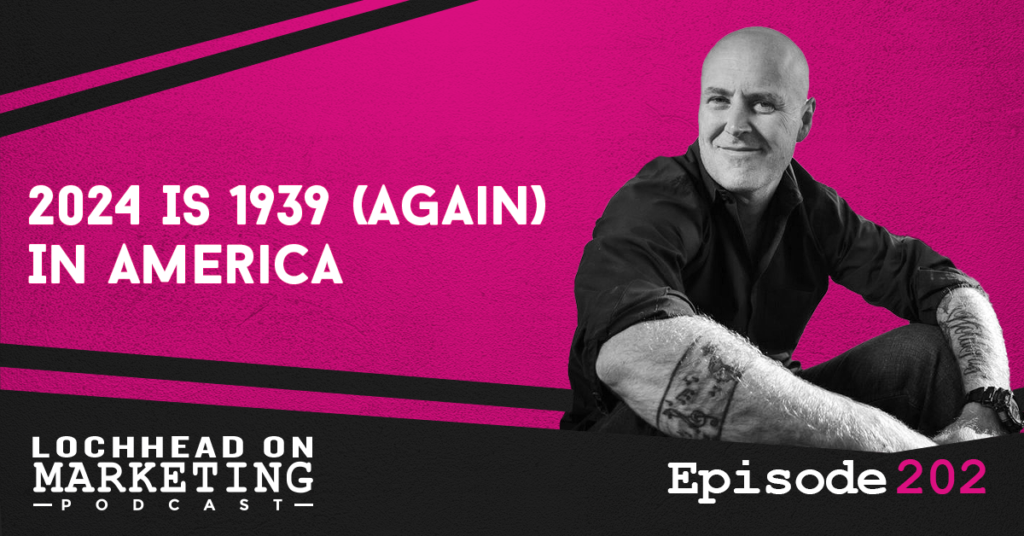
Podcast (lochheadonmarketing): Play in new window | Download (Duration: 31:46 — 21.8MB) | Embed
Subscribe: Apple Podcasts | Spotify | RSS | More
On this episode of Lochhead on Marketing, the conversation takes a deep dive into the complex and sensitive situation in Gaza, Palestine, Israel, and the broader Middle East, and how our perception here in America is being warped by misinformation from different sides.
Welcome to Lochhead on Marketing. The number one charting marketing podcast for marketers, category designers, and entrepreneurs with a different mind.
A Feeling of Déjà Vu for America
On the evening of Feb. 20, 1939, the marquee of Madison Square Garden was lit up for the big event: “Pro American Rally.” But it was the farthest thing from being American as can be. Uniformed members of pro-Hitler group The German American Bund carried American and nazi flags.
That being said, In the last week of December 1942, fifty leading German-Americans (including baseball legend Babe Ruth) signed a declaration condemning nazis which appeared in ten major American daily newspapers. Ultimately, American patriots stopped the American nazis.
Looking at the events this week at Columbia, MIT, NYU, and other elite US schools, they mirror much of the hate, horror and scale of The German American Bund. While some were there to genuinely support the civilians trapped in the ongoing conflict, there were others that openly supported Hamas’ extremist actions. It was very ironic to see banners about women and LGBT+ groups support, when they are the most oppressed in the world that these people envision.
What’s even worse is that there were reasons to suspect that these protests were sponsored by people who don’t want to get their own hands dirty.
(Mis)Information is Rampant
One of the downsides of our technological boom is the ease of access to information. Unfortunately, ease of access does not always mean a smart populace.
As information is shared from peer to peer, information gets distorted, if not outright manipulated to suit their agendas, that sometimes the victim comes out on the other end as the one being ganged on, instead of the oppressor.
This particularly true with social media sites, who has become the de-facto source of information for the younger generation. There was even a brief period where young people were lauding a speech that Bin Laden made to justify 9/11. Never mind the atrocities he and his jihadist group committed in the US and international stage, he made a great speech! Totally justified.
Call to Arms
Nazis have attacked America from within before. American patriots stopped them. The only question now is, will you and I empower radical jihadists nazis?
Or will we stop them, like our ancestors did 78 years ago?
To hear more of Christopher Lochhead’s points on the matter, download and listen to this episode.
Bio
Links
WSJ Article on the Anti-Israel Protesters
The World’s Record Holder for Executing Women Has Executed Three Women in Three Days
This Is Ahmad. He Was Queer In Palestine.
We hope you enjoyed this episode of Lochhead on Marketing™! Christopher loves hearing from his listeners. Feel free to email him, connect on Facebook, Twitter, Instagram, and subscribe on iTunes!
201 Category Creation: How To Dam The Demand
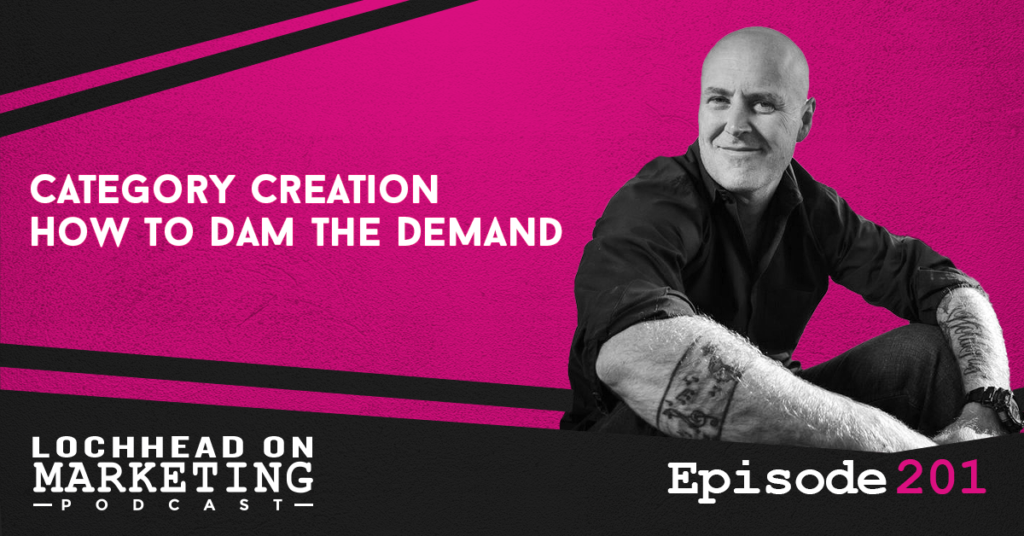
Podcast (lochheadonmarketing): Play in new window | Download (Duration: 11:42 — 8.0MB) | Embed
Subscribe: Apple Podcasts | Spotify | RSS | More
On this episode of Lochhead of Marketing, we review a powerful strategy that has the potential to revolutionize how you approach marketing and demand creation for your product or service. We call this strategy “damming the demand,” and it’s all about redirecting existing consumer desire to carve out a new category that you can dominate.
If you’re not convinced, check out how these giants in the industry have utilized this strategy to their advantage by creating demand in an already existing market.
Welcome to Lochhead on Marketing. The number one charting marketing podcast for marketers, category designers, and entrepreneurs with a different mind.
Dam the Demand
Traditional marketing often focuses on capturing the demand that already exists. It’s about finding a place in the market and filling the needs of consumers who are already looking for solutions. But what if you could do more than just meet existing demand? What if you could create a whole new category of demand?
That’s where the concept of “damming the demand” comes in. It’s a strategy that sits between traditional marketing and category design. Instead of just capturing demand or creating it from scratch, you harness the existing demand and redirect it, creating a new space for your product or service.
Lessons from Tech Titans
Let’s look at some legendary examples to understand this better. Marc Benioff, the founder of Salesforce.com, didn’t just create a cloud CRM; he dammed the demand for traditional on-premise CRM solutions. By evangelizing the benefits of cloud-based CRM, he forced a debate in the market, making businesses choose between the old on-premise solutions and the new, more flexible cloud options. This didn’t just shift the demand—it expanded it, as more and more businesses began to see the value in cloud-based applications beyond CRM.
In the B2C world, Peloton took a similar approach. They saw the demand for spin classes and dammed it by offering an alternative: high-quality home fitness. By doing so, they didn’t just capture the existing market for spin classes; they expanded it to include people who wanted the convenience of working out at home. This created a new category of home fitness solutions that has grown exponentially.
This isn’t a new phenomenon. History is rich with examples of demand damming. Consider Henry Ford, who redirected the demand from horse and buggies to the “horseless carriage,” or Marty Cooper, who shifted the demand from landline phones to the “wireless phone” category. These visionaries didn’t just create products; they created movements that changed the landscape of their respective industries.
The Strategy in Action
So, how can you apply this strategy to your business?
First, identify the existing demand that you can dam. Look for areas where consumers are already spending their money but might be open to a new, better solution. Once you’ve dammed the demand, use it to drive revenue in the near term. Then, leverage this demand to expand and create a new category that you can lead.
Damming the demand is a potent strategy for any company looking to not just compete but dominate a new market category. By redirecting existing demand, you can create a new demand for your category, driving growth and market expansion. It’s a bold move, but as we’ve seen from the likes of Salesforce and Peloton, it’s a move that can redefine your industry and cement your place in history.
Bio
Don’t forget to grab a copy (or gift!) of one of our best-selling books:
Snow Leopard: How Legendary Writers Create A Category Of One
The Category Design Toolkit: Beyond Marketing: 15 Frameworks For Creating & Dominating Your Niche
A Marketer’s Guide To Category Design: How To Escape The “Better” Trap, Dam The Demand, And Launch A Lightning Strike Strategy
 The 22 Laws of Category Design: Name & Claim Your Niche, Share Your POV, And Move The World From Where It Is To Somewhere Different
The 22 Laws of Category Design: Name & Claim Your Niche, Share Your POV, And Move The World From Where It Is To Somewhere Different**NEW!** The B2B Tech Marketer’s Guide To Category Design: How To Engineer Your Market, Find What Makes You Different, And Become A Category Queen
We hope you enjoyed this episode of Lochhead on Marketing™! Christopher loves hearing from his listeners. Feel free to email him, connect on Facebook, Twitter, Instagram, and subscribe on iTunes!
200 Thinking About Thinking Is The Most Important Kind Of Thinking
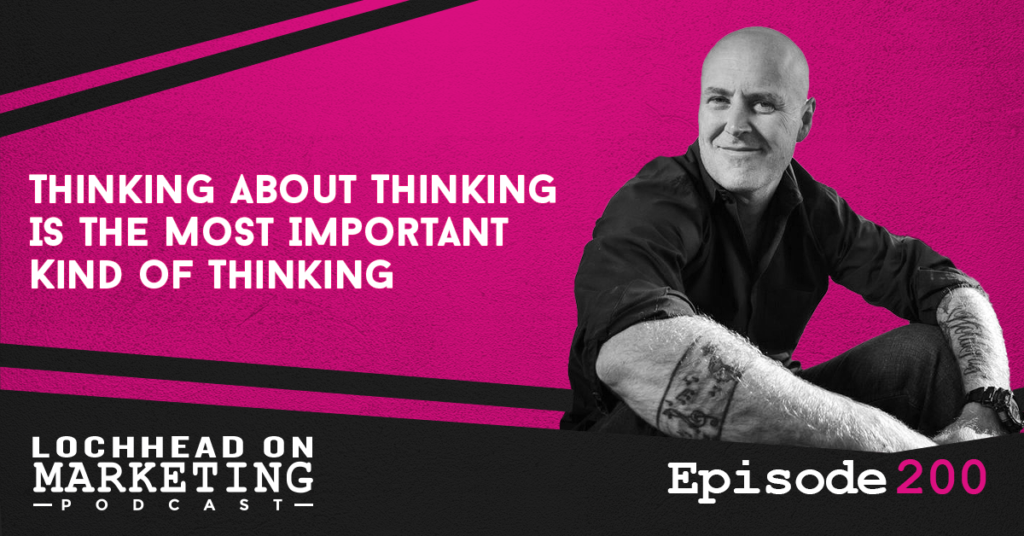
Podcast (lochheadonmarketing): Play in new window | Download (Duration: 17:26 — 12.0MB) | Embed
Subscribe: Apple Podcasts | Spotify | RSS | More
On this episode of Lochhead on Marketing, let’s talk about why thinking about thinking is the most important kind of thinking.
This isn’t just another buzz phrase; it’s a fundamental practice that can revolutionize the way we approach entrepreneurship, marketing, and business strategy. So we thought that it would be a good idea to refresh new listeners minds and remind the old heads why Context is always King.
Welcome to Lochhead on Marketing. The number one charting marketing podcast for marketers, category designers, and entrepreneurs with a different mind.
The Power of Context in Decision-Making
In the realm of business, context is everything. It shapes our discussions, influences our decisions, and ultimately determines the trajectory of our companies. It’s not just about the data or the trends; it’s about grasping the bigger picture and recognizing the underlying currents that drive market dynamics.
Most people, particularly those who are entrepreneurial, have a strong bias to action, diving right in and creating content without the context to support it. However, it does have it downsides sometimes.
“A strong bias to action means that sometimes, and I know I’ve been guilty of this more times than I will ever know, we spring to action without doing enough thinking. More importantly, without doing enough thinking and dialoguing around what the context is for whatever it is we’re talking about.”
– Christopher Lochhead
Rejecting the Premise: A Pathway to Innovation
One of the most exhilarating concepts we discussed was the power of rejecting the premise.
So often, we’re boxed in by traditional ways of thinking, by phrases and concepts that are accepted as industry standards. But what happens when we challenge those premises? When we refuse to accept the status quo? That’s when innovation truly happens.
By rejecting the premise, we open ourselves up to new possibilities, to the potential for creating entirely new categories and leading the market in directions it has never seen before.
Challenging Existing Contexts: The Forward-Thinking Mindset
A key takeaway from this discussion was the importance of challenging existing contexts. It’s easy to fall into the trap of backward thinking, of looking to past successes as a template for future endeavors.
However, the true forward-thinking entrepreneur knows that what worked yesterday might not work tomorrow. By constantly questioning and reevaluating the context in which we operate, we stay ahead of the curve and maintain a competitive edge.
To hear more about how thinking about thinking is the most important kind of thinking, download and listen to this episode.
Bio
Don’t forget to grab a copy (or gift!) of one of our best-selling books:
Snow Leopard: How Legendary Writers Create A Category Of One
The Category Design Toolkit: Beyond Marketing: 15 Frameworks For Creating & Dominating Your Niche
A Marketer’s Guide To Category Design: How To Escape The “Better” Trap, Dam The Demand, And Launch A Lightning Strike Strategy
 The 22 Laws of Category Design: Name & Claim Your Niche, Share Your POV, And Move The World From Where It Is To Somewhere Different
The 22 Laws of Category Design: Name & Claim Your Niche, Share Your POV, And Move The World From Where It Is To Somewhere Different**NEW!** The B2B Tech Marketer’s Guide To Category Design: How To Engineer Your Market, Find What Makes You Different, And Become A Category Queen
We hope you enjoyed this episode of Lochhead on Marketing™! Christopher loves hearing from his listeners. Feel free to email him, connect on Facebook, Twitter, Instagram, and subscribe on iTunes!
199 What Apple’s $110 Billion Stock Buy-Back Means For The Category Queen | Pirates Perspective
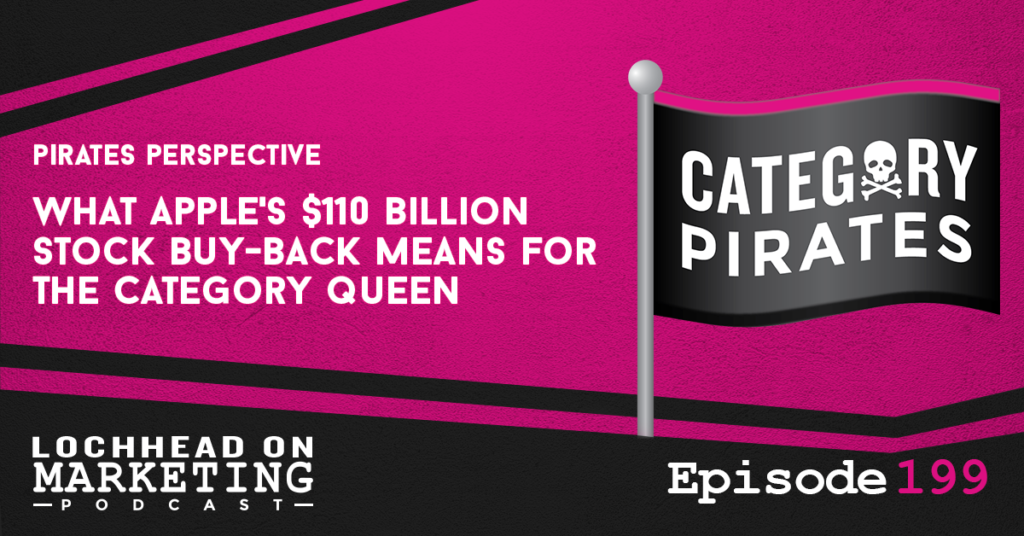
Podcast (lochheadonmarketing): Play in new window | Download (Duration: 18:55 — 13.0MB) | Embed
Subscribe: Apple Podcasts | Spotify | RSS | More
Today on Lochhead on Marketing, we want to share some insights from a riveting discussion we had with Eddie Yoon, our category pirate brother, about a monumental move by Apple.
We’re talking about a colossal $110 billion stock buyback and what it means for the tech giant’s innovation trajectory, particularly in the realm of artificial intelligence (AI).
Welcome to Lochhead on Marketing. The number one charting marketing podcast for marketers, category designers, and entrepreneurs with a different mind.
Apple’s Strategic Crossroads: Innovation or Shareholder Pleasing?
Apple’s decision to buy back stock is a strategic move that has raised eyebrows across the industry.
I’ve always been fascinated by the bold moves that define market leaders, but this move by Apple has us questioning: Is this a sign of maturity and stability, or a red flag signaling a lack of innovative vision?
Warren Buffett, a name synonymous with investment acumen, was famously tech-averse until Apple caught his eye. The staggering 95% retention rate of iPhone users and the undeniable addiction to Apple’s ecosystem reminded him of his investment thesis on Coca-Cola. But as Eddie and I discussed, there’s a nuance to Apple’s success under Tim Cook’s leadership. Despite the financial growth and profitability, the company has struggled to launch new categories—a hallmark of Apple’s DNA.
The Apple Watch: A Beacon of Innovation in the Cook Era
It’s not all a tale of caution, though. The Apple Watch stands out as a testament to Apple’s ability to innovate and create new categories even post-Steve Jobs. It’s a reminder that Apple still has the chops to redefine markets. But the question lingers: Is this enough to sustain Apple’s legendary status?
The crux of the discussion centered on the massive potential of AI, as we’re just at the dawn of what could be the most significant platform shift since the internet. With Apple’s deep pockets, one would expect a torrent of investments in AI, propelling the company to the forefront of this new frontier. Instead, the $110 billion stock buyback seems to suggest a different priority—short-term stock price over long-term category creation.
Microsoft’s Contrasting Strategy: A Global AI Chess Game
Contrast Apple’s strategy with Microsoft’s aggressive global AI investments, and you get a stark picture of two tech titans taking divergent paths.
Microsoft is placing strategic bets on AI across the globe, from the UAE to Malaysia and beyond, positioning itself as a leader in the next wave of technological revolution.
To hear more Pirate talk by Christopher Lochhead and Eddie Yoon, download and listen to this episode.
If you want to join in the discussion, subscribe to Category Pirates and find more Pirates Perspective buried around the beach.
Don’t forget to grab a copy (or gift!) of one of our best-selling books:
Snow Leopard: How Legendary Writers Create A Category Of One
The Category Design Toolkit: Beyond Marketing: 15 Frameworks For Creating & Dominating Your Niche
A Marketer’s Guide To Category Design: How To Escape The “Better” Trap, Dam The Demand, And Launch A Lightning Strike Strategy
 The 22 Laws of Category Design: Name & Claim Your Niche, Share Your POV, And Move The World From Where It Is To Somewhere Different
The 22 Laws of Category Design: Name & Claim Your Niche, Share Your POV, And Move The World From Where It Is To Somewhere Different
We hope you enjoyed this episode of Lochhead on Marketing™! Christopher loves hearing from his listeners. Feel free to email him, connect on Facebook, Twitter, Instagram, and subscribe on iTunes!
198 Complexity Is The Enemy of Revenue: Why It’s Time to Shave The Marketing Dog
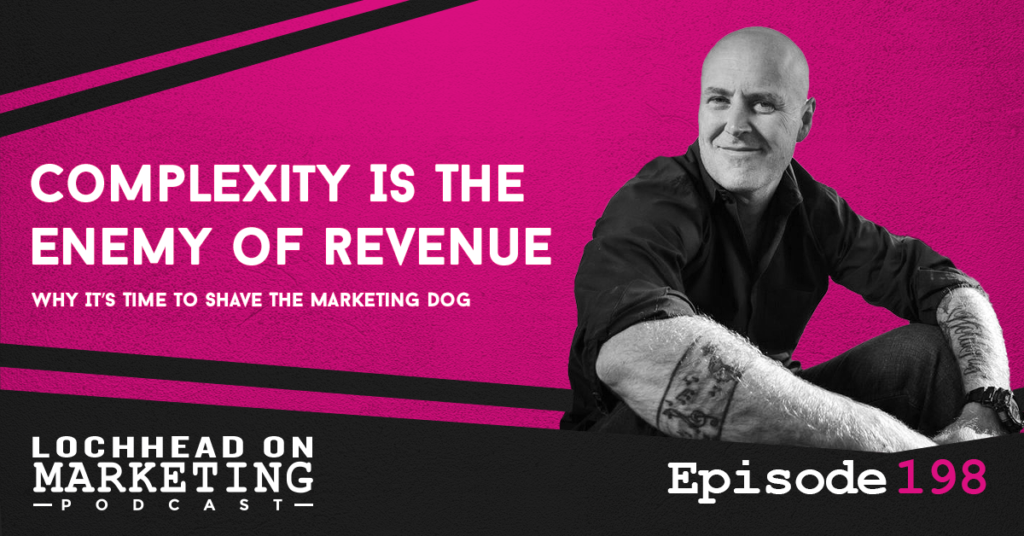
Podcast (lochheadonmarketing): Play in new window | Download (Duration: 14:06 — 9.7MB) | Embed
Subscribe: Apple Podcasts | Spotify | RSS | More
On this episode of Lochhead on Marketing, it’s time again to shave that Marketing Dog with Christopher Lochhead.
If you’re an avid listener of the podcast, you probably think you’re experiencing déjà vu. But we think that people still don’t get this simple concept, that it merits a replay. It is also a good reminder for others who may be falling into the trap of overcomplicating their marketing strategies.
So strap in, and get ready for some timeless advice from yours truly.
Welcome to Lochhead on Marketing. The number one charting marketing podcast for marketers, category designers, and entrepreneurs with a different mind.
Quality Over Quantity: A Bruce Lee Philosophy in Marketing
In the world of marketing, there’s a tendency to equate being busy with effectiveness. However, Christopher likens this to a young fighter who is all showboating but lacks the strategic focus to win. This fighter often ends up being knocked out by a more experienced opponent who understands that precision and strategy trump frantic activity. This analogy perfectly encapsulates the inverse relationship between activity and results in marketing.
The pressure to be omnipresent in the marketing world is immense. Marketers are often told they need to be on every channel, churning out content at an unsustainable pace. But Christopher challenges this notion with a powerful quote from martial arts legend Bruce Lee:
“I fear not the man who has practiced 10,000 kicks once, but I fear the man who has practiced one kick 10,000 times.”
This philosophy is a stark reminder that quality and impact should always take precedence over quantity.
Shaving the Marketing Dog: The Art of Elimination
One of the strategies Christopher advocates for is “shaving the dog,” a metaphor for the practice of eliminating the unnecessary to focus on what truly matters. By force ranking the critical components of a campaign and rigorously evaluating which elements have the maximum impact, marketers can streamline their efforts for better results.
“Shave the dog. Shave that doggy down. Practice getting everything out. Consider getting even more radical.”
– Christopher Lochhead
Thinking Wrong to Do Right
Innovation in marketing often requires us to “think wrong,” to consider what is 180 degrees from what everyone else would do. This approach fosters creativity and differentiation, setting the stage for truly legendary marketing campaigns.
“I learned everything I know about design from a couple of legendary designers and one of them is John Bielenberg. He’s an incredible business and corporate marketing designer. He has a perspective; he calls thinking wrong. The idea is this, when you do anything creative, ask yourself ‘what is 180 degrees from what everybody else would do? What is wrong? What would be the wrong way to go do this?’”
– Christopher Lochhead
This line of thinking also allows you to pursue options that multiply outcomes, as you can sift through the “wrongs” and find those that were rejected, not because it is inherently wrong, but either be not viable in the past, but now doable in our current technology or network.
To know more why Complexity Is the Enemy of Revenue and Why It’s Time to Shave the Marketing Dog, download and listen to this episode.
Bio
Don’t forget to grab a copy (or gift!) of one of our best-selling books:
Snow Leopard: How Legendary Writers Create A Category Of One
The Category Design Toolkit: Beyond Marketing: 15 Frameworks For Creating & Dominating Your Niche
A Marketer’s Guide To Category Design: How To Escape The “Better” Trap, Dam The Demand, And Launch A Lightning Strike Strategy
 The 22 Laws of Category Design: Name & Claim Your Niche, Share Your POV, And Move The World From Where It Is To Somewhere Different
The 22 Laws of Category Design: Name & Claim Your Niche, Share Your POV, And Move The World From Where It Is To Somewhere Different**NEW!** The B2B Tech Marketer’s Guide To Category Design: How To Engineer Your Market, Find What Makes You Different, And Become A Category Queen
We hope you enjoyed this episode of Lochhead on Marketing™! Christopher loves hearing from his listeners. Feel free to email him, connect on Facebook, Twitter, Instagram, and subscribe on iTunes!
197 Tesla Cybertruck: A Masterclass in Lightning Strike Marketing with Eddie Yoon
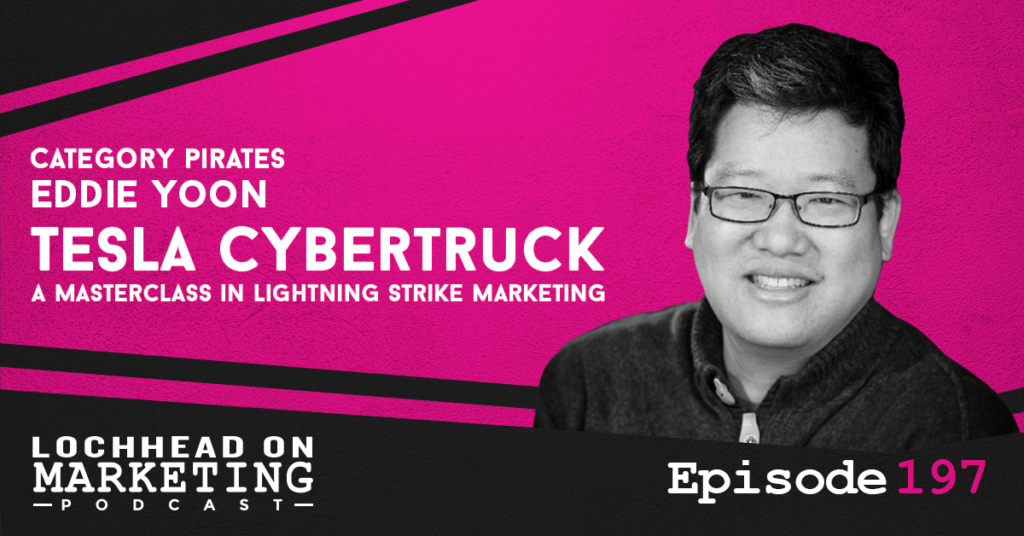
Podcast (lochheadonmarketing): Play in new window | Download (Duration: 6:42 — 4.6MB) | Embed
Subscribe: Apple Podcasts | Spotify | RSS | More
On this episode of Lochhead on Marketing, we are presenting Christopher’s partner, friend, collaborator, and brother from another mother, Eddie Yoon, breaking down how to do a legendary marketing lightning strike with the Tesla Cybertruck as a textbook example.
Eddie Yoon is the category design guru to the S &P 500, and he’s written more about category design in the Harvard Business Review than anyone else alive or dead.
So buckle up for a quick lightning strike of an episode, and hey ho, let’s go! Welcome to Lochhead on Marketing. The number one charting marketing podcast for marketers, category designers, and entrepreneurs with a different mind.
The Concept of a Lightning Strike
Let’s talk about Lightning Strikes.
Lightning Strikes have four critical ingredients: one, it should be profit-center and not an expense. Remember, marketing that does not drive revenue, category potential, or market cap, is just arts and crafts. Lightning Strikes are no different.
Two, Lightning Strikes should be a strike and not a spread – meaning don’t space it over the whole course of the year; it will just dilute the effect of it that way. You want a clear point in time, a quick in and out in a certain area or market, and you’re done. The idea is to get maximum lift without spending too much.
Third, it should have a multiplier effect. It must be engineered to generate word of mouth that lasts beyond the strike itself. You do it buy creating a stunt or a fight, or you want to have a very prominent giveaway. These are the things that people tell their friends and family, and spread from there.
And lastly, you want to be a hijacker or hitchhiker. You want to your lightning strike to take advantage of some broader thing where you take over the conversation, or piggyback off an audience that is already established.
The Cybertruck as a Lightning Strike by Tesla
So, how does the Cybertruck fit into all these things?
Let’s go through the list.
First, the Cybertruck is a profit center in multiple ways. One is the product itself, but it also promotes the broader brand of Tesla motors. Lastly, its components are also something that can be a profit center for later generation of electric cars.
It also has a multiplier effect, as it has generated word of mouth not only from Tesla car owners, but people who are either at awe or making fun of the Cybertruck’s design. Even after it’s short showcase, people are still talking about it. The design is so polarizing: you either hate it, or love it. Either way, you’re going to hear about it. The Cybertruck itself became the stunt it needed for the lightning strike to occur.
Lastly, it’s hitchhiking off the launch of Apple Vision Pro, some people who are using Apple Vision Pro has been seen driving said Cybertrucks in videos and social media. It hit its target well that it hitchhiked in the Apple Vision Pro conversation to some extent, getting a rise from Apple enthusiasts.
And that, my friends, is a successful lightning strike.
If you want to join in the discussion, subscribe to Category Pirates and find more Pirates Perspective buried around the beach.
Don’t forget to grab a copy (or gift!) of one of our best-selling books:
Snow Leopard: How Legendary Writers Create A Category Of One
The Category Design Toolkit: Beyond Marketing: 15 Frameworks For Creating & Dominating Your Niche
A Marketer’s Guide To Category Design: How To Escape The “Better” Trap, Dam The Demand, And Launch A Lightning Strike Strategy
 The 22 Laws of Category Design: Name & Claim Your Niche, Share Your POV, And Move The World From Where It Is To Somewhere Different
The 22 Laws of Category Design: Name & Claim Your Niche, Share Your POV, And Move The World From Where It Is To Somewhere Different**NEW!** The B2B Tech Marketer’s Guide To Category Design: How To Engineer Your Market, Find What Makes You Different, And Become A Category Queen
We hope you enjoyed this episode of Lochhead on Marketing™! Christopher loves hearing from his listeners. Feel free to email him, connect on Facebook, Twitter, Instagram, and subscribe on iTunes!
196 Marketing The Problem, Not Your Solution
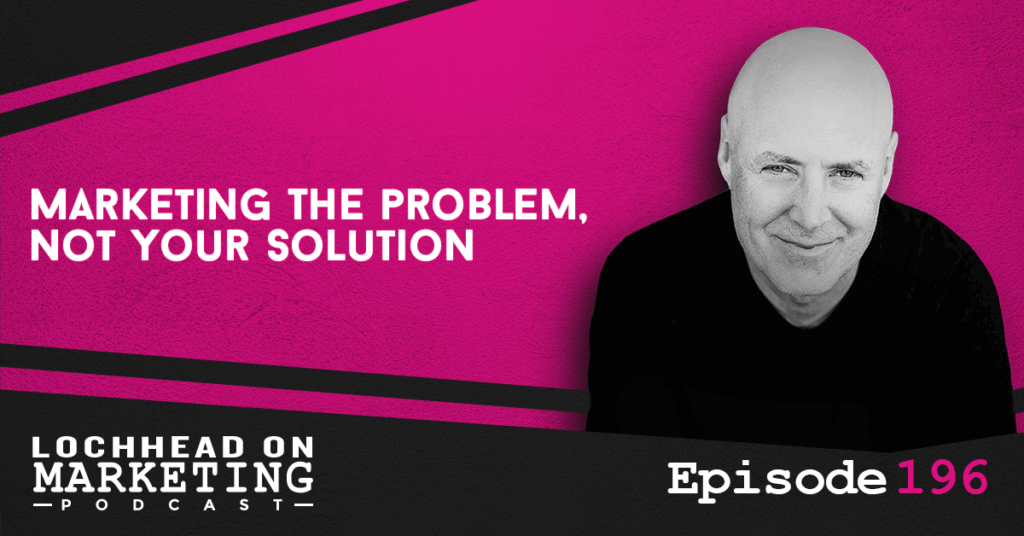
Podcast (lochheadonmarketing): Play in new window | Download (Duration: 18:09 — 12.5MB) | Embed
Subscribe: Apple Podcasts | Spotify | RSS | More
On this episode of Lochhead on Marketing, we talk about why marketing the user’s problem works, but marketing only your brand/product/solutions doesn’t.
Welcome to Lochhead on Marketing. The number one charting marketing podcast for marketers, category designers, and entrepreneurs with a different mind.
The Importance of Understanding Consumer Problems in Marketing
Market your brand/product/solution, and I think you want my money. Market my problem, and I think you want to help me. This is one of the biggest unlocks in category design for marketers. And it comes from a very simple, powerful notion: people do not buy solutions unless they have problems.
Yet a lot of companies do not get this simple concept. For them, it’s always brand awareness this, or advertise this product to the “market”. They play the attention game and call it frequency and reach. But most of the users in that market only see it as a cash grab for said company.
Marketing the Problem Done Right
So here we present a good example of how to market a user problem, and it’s in the form of the American jeans we all know and love.
Over the years, Jeans have come a long way from being those stiff dark blue pants to now being very soft and somewhat comfortable to wear. But therein lies the problem: the thing that makes it soft and pliable is very polluting and very resource-intensive. After which, they present their fix, a “remaking” of the American jeans as we know it.
Framing the Problem to Create Urgency
After naming the problem with the jeans, the article continues to explain that multiple companies have tried working together for years to develop jeans that are soft but not as punishing to the environment and our remaining resources. This serves as a way to intensify the problem by framing it as something that has not been solved. But now, they’ve found a solution. A solution to a problem they themselves proposed.
If you follow that flow, they first introduced a problem that a user can relate to, being that the jeans they wear harms the environment. They then mention that other companies have tried but not yet succeeded in finding a solution. Only after that do they supply the solution, so you can continue to enjoy those comfortable jeans without the previous repercussions and guilt on them. Prompting users to buy new jeans and ditching the old.
And that’s how you market with Category Design.
Link to the article on The Remaking of American Jeans
Don’t forget to grab a copy (or gift!) of one of our best-selling books:
Snow Leopard: How Legendary Writers Create A Category Of One
The Category Design Toolkit: Beyond Marketing: 15 Frameworks For Creating & Dominating Your Niche
A Marketer’s Guide To Category Design: How To Escape The “Better” Trap, Dam The Demand, And Launch A Lightning Strike Strategy
 The 22 Laws of Category Design: Name & Claim Your Niche, Share Your POV, And Move The World From Where It Is To Somewhere Different
The 22 Laws of Category Design: Name & Claim Your Niche, Share Your POV, And Move The World From Where It Is To Somewhere Different**NEW!** The B2B Tech Marketer’s Guide To Category Design: How To Engineer Your Market, Find What Makes You Different, And Become A Category Queen
We hope you enjoyed this episode of Lochhead on Marketing™! Christopher loves hearing from his listeners. Feel free to email him, connect on Facebook, Twitter, Instagram, and subscribe on iTunes!
195 From Category Contenders to Category Kings with Al Ramadan
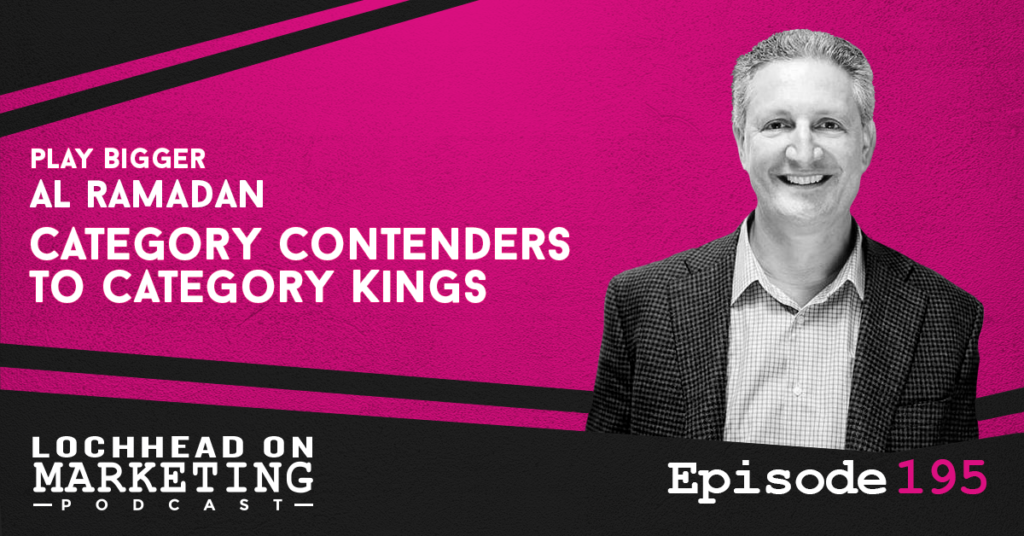
Podcast (lochheadonmarketing): Play in new window | Download (Duration: 1:31:17 — 62.7MB) | Embed
Subscribe: Apple Podcasts | Spotify | RSS | More
On this episode of Lochhead on Marketing, we enjoy the first of many visits from Al Ramadan in 2024, as we talk about moving from being a Category Contender to a Category King.
We’ll dig into what is a category contender in what it takes to win the 18-to-36-month epic category battle that every tech startup faces. So if you’re an entrepreneur or marketing leader who wants to go beyond competing to actually create and dominate your own market, you’re in the right place.
Welcome to Lochhead on Marketing. The number one charting marketing podcast for marketers, category designers, and entrepreneurs with a different mind.
Al Ramadan on Tech Industry Category Development and Dominance
Christopher and Al discuss the concept of being category contenders, reflecting on past research and their book on category kings.
They emphasize the dominance of one company, earning around 76% of the economics in every tech category, despite skepticism. They outline the three phases of category development: define, develop, and dominate, taking approximately 15 years.
They note outliers like open AI and Google’s swift battles, contrasting with Salesforce’s longstanding dominance. They highlight the importance of category design, likening it to a fast-paced battle where one company wins all, stressing its critical role in the tech industry’s landscape.
Market strategy in a competitive industry
Al and Christopher discuss marketing strategies in a competitive industry, emphasizing the importance of a winner’s mindset and setting the agenda.
They share a scenario where a leader in a crowded field differentiates by framing the problem uniquely, focusing on end-user needs rather than feature sets like competitors. Both highlight the futility of incremental strategies and the significance of capturing mindshare by empathizing with customer problems.
They term this the “Battle Royale” for mindshare, where winning means addressing the core problem effectively, rendering feature comparisons irrelevant. Christopher also stresses the pivotal role of understanding customer problems in securing market dominance.
Category design and understanding customer needs
Al and Christopher discuss category design and understanding customer needs. They highlight the importance of framing the problem uniquely to differentiate in a crowded market.
Christopher shares a scenario where a leader in a competitive field focuses on customer needs while competitors emphasize feature sets. They critique the common focus on technology rather than customer-centric solutions, illustrating with examples from Gartner’s history and Google Plus.
They emphasize that categories are about customers’ problems and opportunities, not just technology, stressing the significance of defining the problem scope to win in category battles.
To hear more from this Al Ramadan and Christopher Lochhead dialogue, download and listen to this episode.
Bio
Al Ramadan is a co-founding partner of Play Bigger Advisors and coauthor of the book, Play Bigger. He also co-founded Quokka Sports, which revolutionized the way people experience sport online.
Al then joined Macromedia and Adobe, where he spent almost ten years changing the way people think about great digital experiences. At Adobe, Al led teams that created the Rich Internet Applications category and helped develop the discipline of experience design.
In the early ‘90s he applied data science to Australia’s Americas Cup — an innovation in sports performance analytics. His work in sailing led directly to the idea for Quokka. He lives in Santa Cruz, California.
Links
Connect with Al Ramadan!
Play Bigger | LinkedIn | Category Contenders | The Science Behind Category Design
Don’t forget to grab a copy (or gift!) of one of our best-selling books:
Snow Leopard: How Legendary Writers Create A Category Of One
The Category Design Toolkit: Beyond Marketing: 15 Frameworks For Creating & Dominating Your Niche
A Marketer’s Guide To Category Design: How To Escape The “Better” Trap, Dam The Demand, And Launch A Lightning Strike Strategy
 The 22 Laws of Category Design: Name & Claim Your Niche, Share Your POV, And Move The World From Where It Is To Somewhere Different
The 22 Laws of Category Design: Name & Claim Your Niche, Share Your POV, And Move The World From Where It Is To Somewhere Different- 🏴☠️ **NEW!** The B2B Tech Marketer’s Guide To Category Design: How To Engineer Your Market, Find What Makes You Different, And Become A Category Queen
We hope you enjoyed this episode of Lochhead on Marketing™! Christopher loves hearing from his listeners. Feel free to email him, connect on Facebook, Twitter, Instagram, and subscribe on iTunes!
194 How Important Is Framing, Naming, and Claiming A Problem? | Pirates Perspective
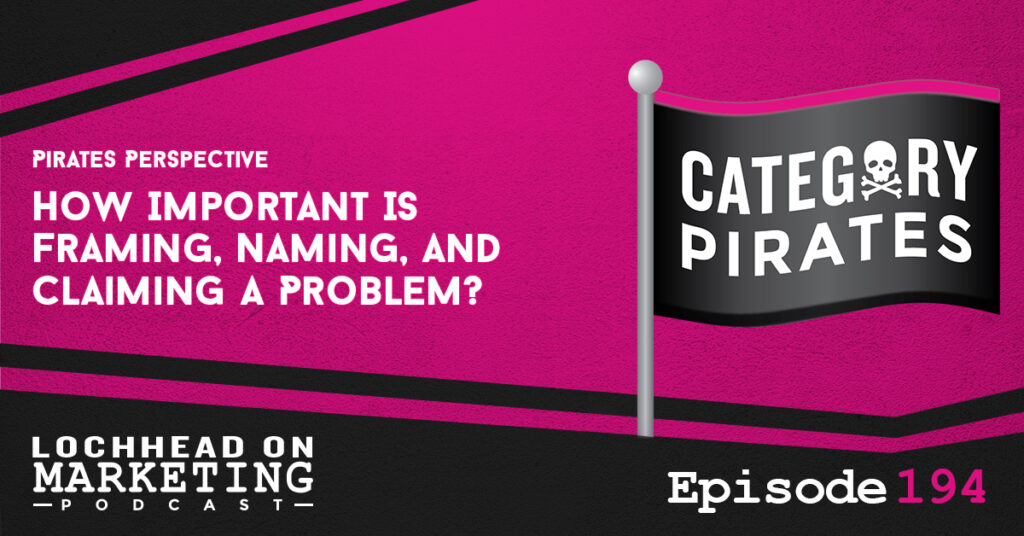
Podcast (lochheadonmarketing): Play in new window | Download (Duration: 11:43 — 8.0MB) | Embed
Subscribe: Apple Podcasts | Spotify | RSS | More
Today is a fun conversation with my fellow Pirates Eddie Yoon and Katrina Kirsch, as we talk about the importance of Framing, Naming and Claiming a problem, to create a different solution for your business.
From time to time, we drop these video discussions that three of us have in Category Pirates, and this one I thought you might also enjoy. If you do enjoy this kind of content, you can check us out at CategoryPirates.com And subscribe to the Category Pirates newsletter.
Welcome to Lochhead on Marketing. The number one charting marketing podcast for marketers, category designers, and entrepreneurs with a different mind.
The Importance of Naming, Framing, and Claiming in Business
When asked by Kristina on what “problem” does category design “Name, Frame, and Claim”, Christopher responds that category design solves the fundamental challenge of defining and owning a distinct market space. It asserts that successful companies excel in three areas: creating legendary business models, products/services, and categories. He emphasizes that a company must recognize category design as a crucial third of its success.
Eddie reinforces this, highlighting the importance of capturing a significant portion of the market share by framing, naming, and claiming a category. He argues that failing to do so results in competing for a smaller market share, which is familiar but less lucrative.
Ultimately, effective category design enables a company to articulate its unique value proposition clearly, ensuring it stands out to customers, investors, and employees.
The Value of being an “Exponential Different” in Business
The next part of the conversation delves into the concept of being an “exponential difference” in business, emphasizing the contrast between incremental improvements and exponential innovations.
Christopher reflects on his career, realizing that focusing on exponential changes often leads to friction within companies geared towards incremental progress. He highlights the importance of recognizing when to contribute to exponential shifts and when to step back, as pushing too hard on exponential change can disrupt the organization.
This understanding prompts a shift in perspective, reframing what was once seen as a career obstacle into a strategic advantage. Overall, it underscores the necessity of balancing incremental improvements with exponential innovations for sustainable growth and success in business.
If you want to join in the discussion, subscribe to Category Pirates and find more Pirates Perspective buried around the beach.
Don’t forget to grab a copy (or gift!) of one of our best-selling books:
Snow Leopard: How Legendary Writers Create A Category Of One
The Category Design Toolkit: Beyond Marketing: 15 Frameworks For Creating & Dominating Your Niche
A Marketer’s Guide To Category Design: How To Escape The “Better” Trap, Dam The Demand, And Launch A Lightning Strike Strategy
 The 22 Laws of Category Design: Name & Claim Your Niche, Share Your POV, And Move The World From Where It Is To Somewhere Different
The 22 Laws of Category Design: Name & Claim Your Niche, Share Your POV, And Move The World From Where It Is To Somewhere Different
We hope you enjoyed this episode of Lochhead on Marketing™! Christopher loves hearing from his listeners. Feel free to email him, connect on Facebook, Twitter, Instagram, and subscribe on iTunes!

